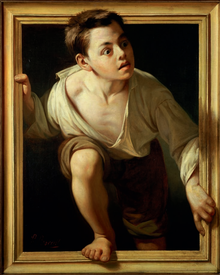trompe l'oeil
Jump to navigation
Jump to search
English
[edit]Alternative forms
[edit]
Etymology
[edit]Borrowed from French trompe-l’œil (literally “deceives the eye”), from trompe (“deceives”, third-person singular present indicative of tromper) + l’ (“the”, prevocalic form of le) + œil (“eye”).
Pronunciation
[edit]- (Received Pronunciation) (emulating French) enPR: trôɴp löy, IPA(key): /ˈtɹɔ̃p ˈlœj/
Audio (Southern England): (file) - (General American) IPA(key): /ˈtɹɔmp ˈlɔɪ/, /-ˈleɪ/
Noun
[edit]trompe l’oeil (usually uncountable, plural trompe l’oeil or trompe l’oeils) (see usage notes)
- (uncountable) A genre of painting that exploits human vision to create the illusion that the subject of the painting is real.
- 1976 September, Saul Bellow, Humboldt’s Gift, New York, N.Y.: Avon Books, →ISBN, page 74:
- It looked like a private apartment, and yet it seemed also to be a place of business. It was furnished in decorative style with plastic, trick art objects hanging on the walls, geometrical forms of the trompe l'oeil type that intrigue business people. They are peculiarly vulnerable to art racketeers.
- 2023 March 16, Julia Felsenthal, “An Artist Whose Work Might (Possibly) Have Its Own Free Will”, in The New York Times Style Magazine[1]:
- In 2008 they moved to New York, where they made waves at the 2010 Whitney Biennial with their “Fold” paintings, spray-painted canvases that were flat but seemed crumpled, a trompe l’oeil trick that reflected the artist’s enduring preoccupation with interdimensionality.
- (countable) A painting of this kind.
Usage notes
[edit]- This phrase is sometimes misconstructed as trompe d’œil and trompe-d’œil, which, literally interpreted in French, means “deceives of eye”.
- In French, trompe-l’œil is an invariant noun; the same usage is reflected in the plural use of the English trompe l’oeil. Alternatively, trompe l’oeil is treated as a headless noun phrase, to which is suffixed -s to form a regular plural form. Still otherwise, some authors form novel plurals on modified etymological bases, such as the technically correct trompent-l’œil (“[they] deceive the eye”) and the ultimately mistaken trompe les yeux (“deceives the eyes”); however, such neologistic constructions are vanishingly rare.
Synonyms
[edit]Translations
[edit]genre of still life painting
|
painting of this kind
|
See also
[edit] Trompe-l'œil on Wikipedia.Wikipedia
Trompe-l'œil on Wikipedia.Wikipedia
References
[edit]- “‖trompe l’œil” listed in the Oxford English Dictionary [2nd Ed.; 1989]
French
[edit]Noun
[edit]trompe l’oeil m (plural trompe l’oeil)
- Nonstandard spelling of trompe-l’œil.
Usage notes
[edit]- The œ ligature is often replaced in contemporary French with oe (the œ character does not appear on AZERTY keyboards), but this is nonstandard.
Italian
[edit]Etymology
[edit]Unadapted borrowing from French trompe-l’œil (literally “deceive the eye”).
Noun
[edit]trompe l'oeil m (invariable)
Categories:
- English terms borrowed from French
- English terms derived from French
- English terms with IPA pronunciation
- English terms with audio pronunciation
- English lemmas
- English nouns
- English uncountable nouns
- English countable nouns
- English multiword terms
- English terms with quotations
- en:Art
- en:Painting
- French lemmas
- French nouns
- French countable nouns
- French multiword terms
- French masculine nouns
- French nonstandard forms
- Italian terms borrowed from French
- Italian unadapted borrowings from French
- Italian terms derived from French
- Italian lemmas
- Italian nouns
- Italian indeclinable nouns
- Italian countable nouns
- Italian multiword terms
- Italian masculine nouns
